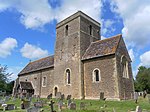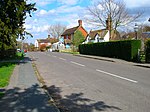Shipley, West Sussex

Shipley is a village and civil parish in the Horsham District of West Sussex, England. It lies just off the A272 road 6 miles (10 kilometres) north-east of Storrington. The parish includes the village of Coolham and the hamlets of Dragon's Green, Brooks Green and Broomer's Corner. Shipley is first mentioned in a charter of 1073 as Scapeleia, and in the Domesday Book of 1086 as Sepelei. The name derives from the Old English scēap ('sheep') and lēah ('open ground, such as meadow, pasture, or arable land'). Thus it means 'sheep-clearing' or 'sheep-pasture'.The western River Adur flows through the village, where it meets a significant tributary, Lancing Brook. The parish has a land area of 3,125 hectares (7,720 acres). In the 2001 census 1075 people lived in 448 households of whom 596 were economically active. At the 2011 Census the population included the hamlet of Coolham and increased to a total of 1,147.Shipley was home to Hilaire Belloc who in 1906 purchased Kings Land, with a house, 5 acres (2 ha) and Shipley Windmill, which was used in the television series Jonathan Creek as Creek's residence.The churchyard of St. Mary the Virgin is the burial place of composer John Ireland (1879–1962).
Excerpt from the Wikipedia article Shipley, West Sussex (License: CC BY-SA 3.0, Authors, Images).Shipley, West Sussex
Red Lane,
Geographical coordinates (GPS) Address Nearby Places Show on map
Geographical coordinates (GPS)
| Latitude | Longitude |
|---|---|
| N 50.98539 ° | E -0.37078 ° |
Address
Red Lane
RH13 8PH
England, United Kingdom
Open on Google Maps










